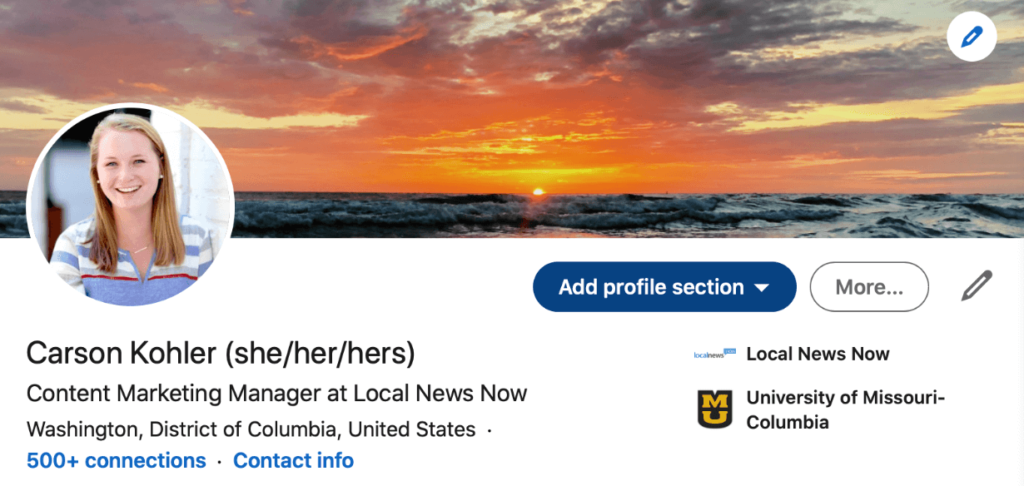
New clients, unlock 10% off all plans 🔥 at checkout with code: CEO10SPECIAL (Limited Time Offer)
New clients, unlock 10% off all plans 🔥 at checkout with code: CEO10SPECIAL (Limited Time Offer)






Pronoun as defined by Merriam-Webster dictionary is “a word that is used instead of a noun or noun phrase. Pronouns refer to either a noun that has already been mentioned or to a noun that does not need to be named specifically”.
Any of a small set of words (such as I, she, he, you, it, we, or they) in a language that are used as substitutes for nouns or noun phrases can be referred to as pronouns.
Further examples given are they/them/theirs, he/him/his, and she/her/hers, etc.
The use of pronouns is becoming more common to see in email signatures and zoom boxes, but should you put them on your job search documents as there’s no set rule that applies since your decision to include your pronouns is a personal one as the case may be?
Within a job application process, there are few ways you can specify your pronouns.
It is more important to add your pronouns under your name in the header (before your contact information) only if you want to include on your resume.
Read also: Words and Phrases to Remove from Your Resume Right Away
You can also include your pronouns beneath your signature at the bottom of the page which is a less obvious way to include on your cover letter.
Another way is to attach your pronouns in parentheses next to your name.
Finally, an additional line can be added under your name or title and you may be required to identify your salutation of Mr./Ms./Dr./Other sometimes by your job application.

Just Including pronouns on a document can feel intimidating to some people at the same time, benefit some job seekers.
Though the ill truth is that there’s still discrimination in hiring, so putting your pronouns on your documents is ultimately your choice to make.
Here are some vital reasons why you may wish to include pronouns on your resume. They are:
One of the reasons why people include pronouns on their resume is to avoid situations where they may feel pushed to correct a potential employer when they mistakenly use the wrong pronouns.
Putting your pronouns on your https://www.comedianjoshwolf.com/ resume is one sure way to avoid any accidental misgendering during an interview or in a later interview/phone screen conversation because people don’t wish to get your pronouns wrong provided you correctly list them on your resume.
The idea of putting your pronouns in your resume is another means or way to eliminate stress when you list them on your resume.
It takes away the feelings of anxiety when you find yourself going into an interview or professional setting and potentially having to clarify your pronouns and gender identity.
Haven listed your pronouns allows you to feel comfortable and safe going into an interview so you can remain focused on your work experience and qualifications.
In this situation you don’t have to correct a hiring manager who misgender you.
You might like: How to Write a Resume With No Work Experience (Best Guide)
It encourages essential step towards inclusivity.
Whether you are cisgender, transgender or non-binary, putting your pronoun on professional materials such as resume is a far important step towards workplace inclusivity.
According to Max Masure a co-founder of Argo Collective, an organization wired with the sole aim of helping workplaces build inclusive cultures said:
“Including pronouns in your professional materials is a great way to show someone you are an LGBTQ + ally”.
Balancing the usage of pronouns is a sure and impactful way to show one’s advocacy for LGBTQIA + individuals.
However you identify, it helps more people than you think when you are proud of your pronouns as well as encouraging others out there too.
In some situation, many will react against putting your pronouns on your resume believing it can lead to discrimination but little did they know that there’s a great benefit.
Putting your pronouns on your resume can help weed out non- inclusive workplaces for instance a company may find you totally qualified for the job being identified as a non-binary but refuse to invite you for an interview.
You can tell from there that such a company may not make you feel comfortable working for them.
It will be a great idea if you decide to put your pronouns on your resume like your email signature or LinkedIn profile. Here are some guides to help you achieve this the right way.
If you have to include your pronouns on your resume, you can add these under your name in the header. Include it as you list your contact information.
Most online job applications if not all may require you to select your gender.
In this case, you can select “genderqueer/nonbinary” if it’s an option. If not, select the option “other.”
Also, you can always decide not to reveal that information.
You can add your gender pronouns to your email signature which is simply important to help avoid misgendering and facilitate inclusivity.
You can put your pronouns in parentheses next to your name or add an additional line under your position and contact information.
While LinkedIn doesn’t have a section where you can share your pronouns, you can easily add them to the end of your last name by editing your intro information.
This is what it looks like:

One fact we must understand is that there’s no right or wrong answer especially when it comes to putting your pronouns on your resume or other professional materials.
At the end, it’s vital to accept what makes you most comfortable going into your job-search process.
Are you looking to ensure your resume is strong enough to land you that dream job? Our certified resume writers can help you out.
Further reading:
Does an Internship Count as Professional Work Experience?
The 5 Best Job-Search Apps to Find Your Dream Job in 2022
Share
Further Reading
*The names and logos of the companies referred to in this page are all trademarks of their respective holders. Unless specifically stated otherwise, such references are not intended to imply any affiliation or association with CEOMichaelHR.
Land interviews 3x faster while submitting fewer resumes
Copyright © 2025, ceomichaelhr.com.
All rights reserved.
Land interviews 3x faster while submitting fewer resumes
Copyright © 2025, ceomichaelhr.com.
All rights reserved.

Learn the same techniques our expert resume writers have used to get thousands of clients closer to their next job
Unlock expert resume tips, start landing multiple interviews!

Stay connected to receive powerful career insights, updates, and inspiration that’ll help you hit your career goals.